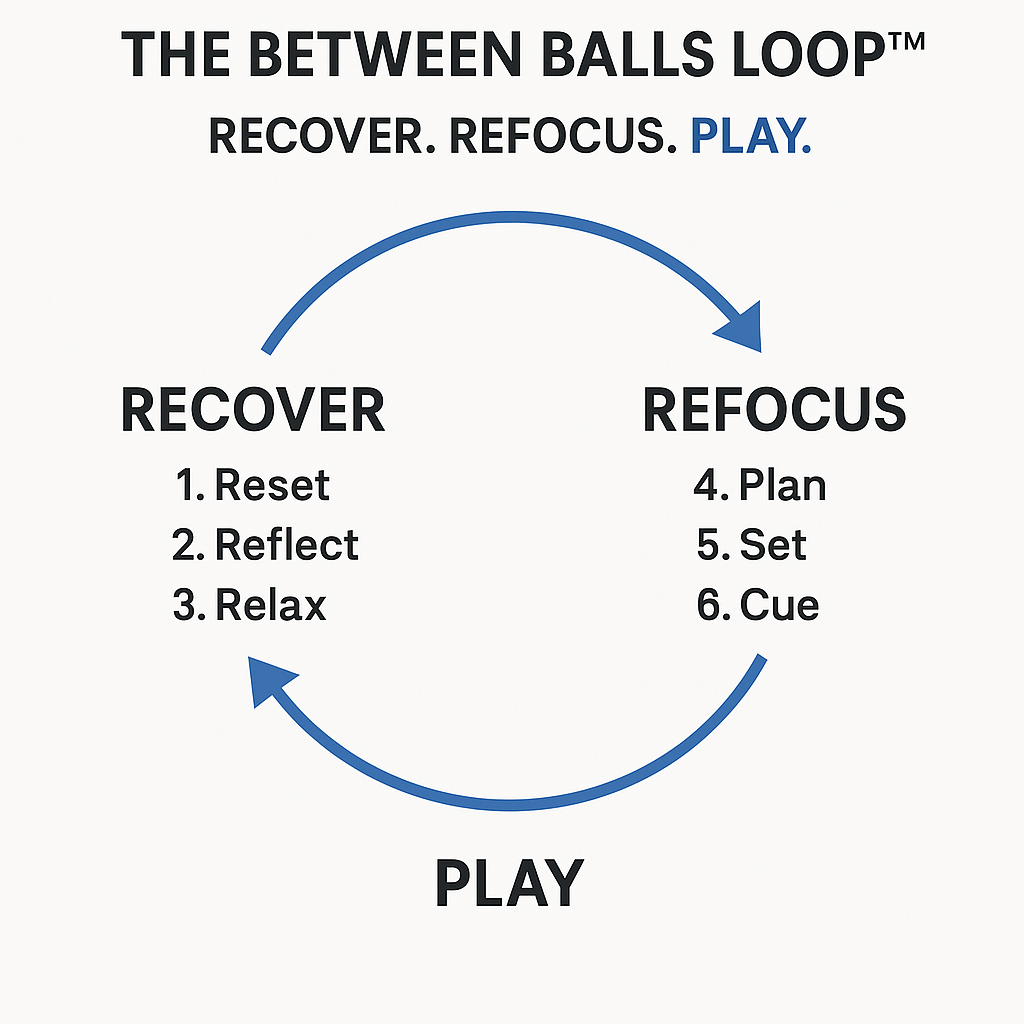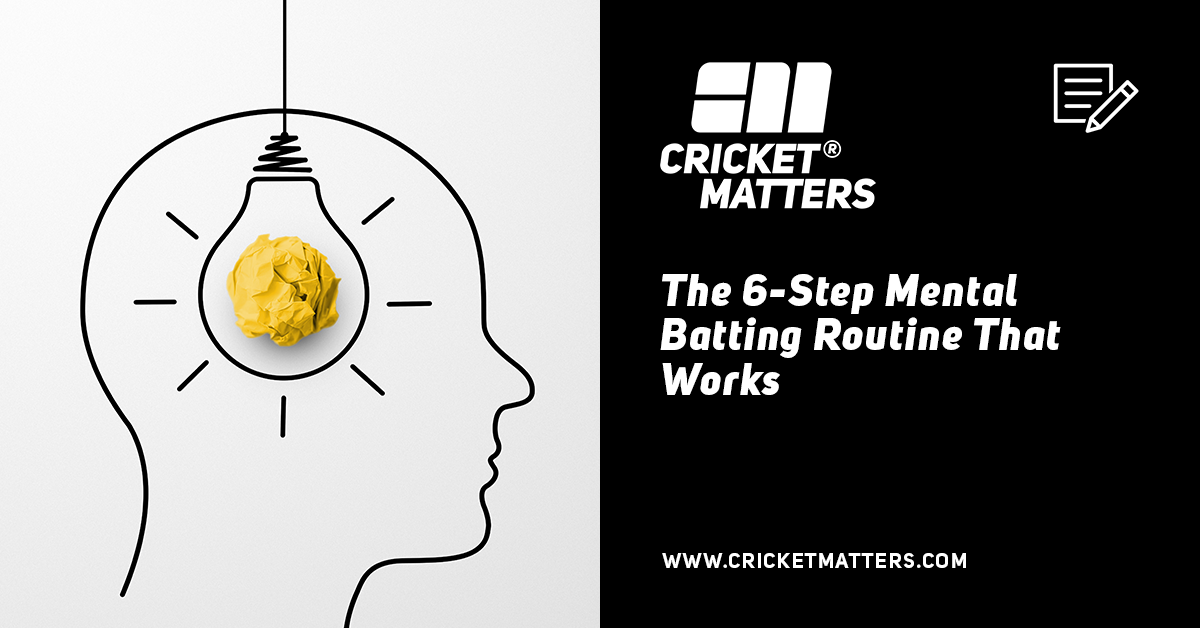
I hope you enjoy reading this blog post.
James Breese, Cricket Matters FounderIf you need my help with cricket coaching, strength and conditioning, injury rehab, or nutrition, click here.
It’s not the flashy cover drive that wins matches.
It’s the space between balls—when nothing’s happening—where games are won or lost.
That’s where focus slips. That’s where matches unravel.
Most batters don’t fail because they lack skill. They fail because they lose control of their mind between deliveries.
They get stuck in the past. Or jump into the future. They think too much. Or not at all. And suddenly, they’re walking off, wondering how they let it slip.
But it doesn’t have to be that way.
What you do between balls is a skill. And like any skill, it can be trained.
This isn’t about mindset theory or motivational fluff. It’s a practical, field-tested mental routine high-performing cricketers use to stay composed, locked in, and ready to perform—one ball at a time.
It’s simple, repeatable, and personal. Once you install it, everything about how you bat changes.
In this article, I’ll walk you through the six-step mental routine for batting that bridges the gap between chaos and clarity.
Whether you’re a young player just starting, a club cricketer chasing consistency, or a coach working with developing athletes, this routine works.
Because it’s built on how the brain performs under pressure, and it’s been pressure-tested, ball after ball, on real fields with real players.
Key Takeaways
- Discover the 6-step mental routine elite cricketers use to stay calm, focused, and ready between every ball.
- Learn how to train your mind like your technique—using structure, not superstition.
- Build composure under pressure with a routine grounded in science, not guesswork.

Have You Downloaded Our FREE 7-Day Gym Workout Plan?
Grab your complete step-by-step 7-day gym workout plan for cricketers today. There will be no more Guesswork. Just follow the plan and get results.
Table of Contents
Why the Mental Side of Batting Matters

Batting is more than technique. It’s more than drills, reps, and perfect swing paths. When the pressure’s on, your mindset determines what happens next.
Cricket is a game of decision-making, ball after ball. Do you play? Do you leave? Do you commit or wait?
Those decisions don’t just come from instinct. They come from clarity. And clarity only exists when the mind is calm.
That’s where most players lose it. Not with the wrong shot—but with the wrong state.
They get emotional. They rush. They overthink. One ball turns into two, and soon a good innings is gone before it starts.
Watch the greats—Kane Williamson, Joe Root, Steve Smith.
What stands out isn’t just their technique. It’s how composed they are between deliveries.
They control their breath and body language. They switch off and then switch back on with intent.
It’s not luck. It’s not personality. It’s a skill.
They use the time between balls to recover and reset—mentally and physically. They don’t carry the last ball into the next one. They step away, re-centre, and return with purpose.
This is where most club cricketers struggle.
They train hard in the nets, but come game time, their mind runs ahead of them. Or worse, runs away from them.
The real battleground in cricket isn’t the shots you play. It’s the space between balls.
Get that right, and everything changes. Your shot selection improves. Your reactions sharpen. Your confidence grows.
Because when your mind is in the right place, your body follows.
And that’s precisely what the 6-step Cricket Matters mental routine is built to deliver.
The 6-Step Mental Routine for Batting

Batting isn’t just about playing the ball—it’s about preparing for it properly. What you do between deliveries sets the tone for what happens during them.
This routine is split into two parts: Recover and Refocus.
The Recovery phase aims to physically, emotionally, and mentally clear the mind of the previous delivery.
In the Refocus phase, the focus shifts to preparing for the next ball with clarity and intent.
It’s simple. Repeatable. And powerful under pressure.
Here’s how it works.
Recovery Phase
- 1. Reset: Use a physical action to disconnect from the last ball. Walk away. Adjust your gloves. Look out toward square leg. Whatever works for you. The point is to draw a line under the previous moment—good, bad, or neutral.
- 2. Reflect: Ask yourself, “Was I calm, relaxed, balanced?” Not: “Did I play that well?” This is a state check, not a judgment. If something felt off, make a note. If it felt good, trust it.
- 3. Relax: Let it go. Drop your shoulders. Hum a tune. Look around. This is where you conserve energy. You don’t need to stay ‘on’ for every second—you need to know when to switch off.
Refocus Phase
- 4. Plan: Decide on your intent for the next ball. Make just one clear plan—not a list of what-ifs. Intent focuses your body and sharpens your reaction.
- 5. Set: Step into position. Guard. Tap. Breathe. This is where you lock back in—physically and mentally. You’re no longer switching off. You’re getting ready to compete.
- 6. Cue. As the bowler runs in, give yourself one final instruction on the point of release. A single word or phrase. This cue blocks out noise, silences doubt, and narrows your attention to what matters most.
This routine isn’t about superstition or rituals. It’s about creating structure in the space between balls—so you can show up with clarity, calm, and intent for every single delivery you face.
Breaking It Down: The Recovery Phase

Before you can focus, you need to recover. That starts with a reset—physical first, then mental.
Reset Isn’t Superstition—It’s Strategy
Elite batters don’t just walk away from the crease because it looks good on camera. They do it because it works.
A 2015 study by Abbas & North analysed over 1,000 deliveries in professional cricket.
They found 82% of elite players used a consistent behavioural routine before facing each ball.
What are the most common reset actions?
- Walking away from the crease
- Looking toward square leg
- Adjusting gloves
- Taking a breath before stepping back in
These weren’t quirks. They were part of a system, actions that helped players mentally separate one delivery from the next.
More than half of all deliveries involved players repeating the same sequence.
It wasn’t performance theatre. It was performance control.
And it got sharper under pressure. Nine of the players studied modified their routines slightly in tense, pressure situations—switching from foot shuffles to a smaller, more grounding movement. That’s awareness. That’s adaptation.
Another report, from sports psychologist Dr. Cotterill, showed how these routines are built deliberately.
He worked with elite cricketers before a season to help them design personal reset actions.
Some tapped the bat. Others took a breath.
One had a triple-check routine:
- Walk to square leg
- Ask: “Was I balanced?”
- Tap the crease twice
Over time, these reset behaviours became automatic. Players who used them consistently reported:
- Better emotional control after a poor shot
- Sharper focus under pressure
- Improved decision-making at the crease
Reset isn’t a luxury. It’s a foundation.
If you’re walking straight back to your mark without breaking the moment, you’re not in control of your state—you’re riding it. And at higher levels, that can cost you your wicket.
The best players in the world use reset actions for a reason:
- To let go.
- To breathe.
- To be ready again.
Reflect: Awareness Creates Control
The best batters don’t just manage their technique. They manage their state. And they do it ball by ball.
In a study published in PLOS ONE, researchers interviewed elite-level batting coaches—all former international or first-class players—about what truly separates top batters from the rest (Connor, Renshaw, & Farrow, 2020).
The answer wasn’t just footwork or shot selection.
It was self-awareness.
The best players knew exactly how they were feeling between deliveries. They checked in with themselves. Silently. Consistently.
Questions like:
“Was I in control of that shot?”
“Was I balanced in my setup?”
“Was my mind calm before the ball came down?”
These weren’t outcome questions. They were process checks. And that’s what matters. Because focusing on internal state—rather than runs or mistakes—keeps you grounded.
Coaches noted that players who mastered this kind of reflection were more adaptable. They didn’t spiral after a mis-hit. They stayed composed, recalibrated, and moved on.
A second study took this further.
In a four-week mental skills intervention with a state-level women’s team, researchers introduced pressure inurement training—a structured way to expose players to stress in training so they could regulate it in matches (van Rens et al., 2020).
The result?
Players reported better emotional control, improved confidence, and a clearer sense of when they were under pressure, and what to do about it.
One player said:
“I now know what pressure feels like in my body and how to spot it.”
Another added:
“Reflecting between balls helps me control the tempo of my thoughts.”
These findings reinforce the Reflect step as a practical tool—not just a nice idea.
It gives you a moment to stop the mental noise. To assess without emotion and to stay with the process, not the past.
Relax: Don’t Stay Switched On

You don’t need to be “on” all the time to perform. If you are, you’ll burn out.
This is where the Relax step comes in.
It’s not laziness. It’s not losing focus. It’s strategic. Deliberate. And completely backed by research.
A study by Veness et al. (2017) showed that elite cricketers exposed to just 30 minutes of mental fatigue before performing sprint and reaction-based tasks performed worse across the board.
- Their reaction time dropped.
- Their running between wickets slowed.
- And their endurance collapsed.
They weren’t physically tired. They were mentally drained.
And in a long innings, that kind of fatigue builds up silently.
That’s why the best players find ways to switch off briefly between balls. A moment of mental recovery—before switching back on.
Another study found that senior players scored significantly higher on “Relaxation Ability” than juniors (Hazra & Biswas, 2018).
The more experienced the player, the more likely they were to let go, breathe, and mentally reset after each delivery. It wasn’t natural talent—it was a skill they’d trained.
And it works.
In a separate study, university-level cricketers reported using personal “anchors” to relax between balls—like humming a tune, staring out at the boundary, or focusing on their breath (Slogrove et al., 2002).
These players weren’t checking out. They were managing intensity.
Relaxation isn’t downtime. It’s a performance strategy.
- It drops the mental load.
- It helps you recover.
- And it protects your clarity, ball after ball.
If you never step back mentally, pressure will eventually step in.
Breaking It Down: The Refocus Phase

Recovery clears the head. Refocus brings the intent. This is where you shift from being composed to being dangerous.
Plan: One Ball, One Intent
This isn’t about guessing the next ball. It’s about entering it with clarity.
In the Plan phase, your job is to make one clear decision—either:
- Play the ball on merit with strong intent and focus, or
- Execute a specific plan based on the match situation, field, or bowler (e.g. “If long on and off are up, I’m coming down to go over long-on.”)
Both are valid. The key is that you pick one, and only one. Most club players should focus on just point one.
The research shows that players who enter each delivery with a single intent—reactive or proactive—respond faster, judge length better, and execute more cleanly.
A 2015 study (Stevenson et al.) found that elite batters pre-activate their intent based on early visual cues, preparing for front-foot or back-foot movement before the ball is released.
Novices, by contrast, react late and hesitate—because they haven’t committed to a plan.
This principle extends across sports.
In baseball, hitters who trained with variable hitting plans (e.g. “pull to right”, “pop up on purpose”) became more adaptable and accurate (Gray, 2025).
In golf, elite players plan every shot, not just in general terms, but in specifics: “fade to centre of green with soft hands.”
That clarity builds trust, lowers cognitive load, and sharpens execution.
Same in cricket.
Planning isn’t locking yourself in. It’s giving your mind a job.
“I’m going to paddle sweep this ball”
“I’m going to reverse sweep.”
“I’m going to plan the ball on merit.”
No maybes. No clutter. Then commit.
You can always adjust if the ball doesn’t match your plan. The best batters always have a good plan b.
But if you wait to decide mid-flight, it’s usually too late.
Coaching tip: Train with scenario-based plans. For example:
- Against spin: “Sweep every ball”
- Against pace: “Show intent”
Build a mental library of standard plans. Then trust one each ball.
Bottom line: It must be clear whether your plan is reactive or proactive. One ball. One intent.
Set: Lock Into Rhythm, Prime the System

You’ve made your plan. Now it’s time to get ready to execute.
The Set phase is your bridge between intent and action. It’s physical, not just habit—it’s preparation.
What you do in this moment sets the tone for how you move, how you react, and how your brain sees the ball.
In a study of over 1,000 deliveries in first-class cricket, researchers found that 63.75% involved the exact same pre-delivery setup:
- Guard check
- Bat tap
- Stance adjustment
- Small visual cue (like looking toward point or the bowler’s hand)
When those behaviours change, they often correlate with pressure or uncertainty (Abbas & North, 2015). In other words, when players drift from their routine, performance tends to follow.
It’s not just cricket.
In golf, players who used consistent pre-shot routines (same grip, breath, stance) improved accuracy and retained performance gains over time (McCann et al., 2001).
In tennis, basketball, and baseball, athletes bounce the ball, shuffle feet, or repeat gestures—not for show—but to anchor focus and prime movement (Yancey, 2007).
That’s what this step does.
- It’s not superstition. It’s structure.
- It gives the brain a signal: We’re ready now.
- It gives the body a rhythm: We know this pattern. Let’s go.
Coaching tip: Help players find their own “Set” sequence—2 bat taps, deep breath, check guard, soft gaze. Keep it short. Keep it consistent. When things get loud or rushed, this is their anchor.
Bottom line: The Set phase is your internal green light. Repeat it. Trust it. Let it carry you into the next ball—ready, composed, and aligned.
Cue: One Word, One Feeling, One Focus

This is the last moment before you act. And it’s not just about what you do—it’s about how you feel when you do it.
The Cue phase is where you give your brain one final instruction.
A word. A feeling. Something that simplifies your focus and locks you into the right mindset for action.
It might be a technical or perceptual cue:
“Watch.”
“Still.”
“Pick.”
These help sharpen attention and eliminate distractions.
But for others, the cue is about the state. It’s not what they need to see—it’s what they need to feel.
“Aggressive.”
“Intent.”
“Dominate.”
These aren’t reminders. They’re identity triggers.
One word that puts the body into the right state: calm, fast, powerful, clear. Not hype. Not over-arousal. Just a clean mental switch.
And the science supports both.
Researchers have shown that a single focus cue improves execution by narrowing attention (Abernethy & Masters, 2011).
However, other studies show that players who can trigger performance states—like calmness, aggression, or urgency—using a cue word or image play with more consistency and emotional control (Neumann et al., 2022).
So what’s your cue?
It might be:
- A word for vision (“watch”)
- A word for movement (“hands”)
- A word for emotion (“aggressive”)
- A word for energy (“breathe”, “present”)
- A word for identity (“dominate”)
Whatever it is, it needs to be yours. One word. One intention. One ball.
Coaching tip: Don’t just ask players what they say—ask what they feel when they say it. That’s the real cue. You’re not just shaping behaviour. You’re shaping identity under pressure.
Bottom line: The Cue is your mental ignition switch. It connects your thoughts, body, and intent—so when the ball is released, you’re already where you need to be.
How to Train the Routine: From Theory to Practice

You don’t rise to the level of your potential—you fall to the level of your preparation.
If you want the routine to hold under pressure, you must train it until it becomes automatic.
Here’s how to do it.
Phase 1: Shadow Batting (No Ball)
Start simple. No bowler. No ball. Just a bat in hand and full focus.
Shadow bat through all six steps:
- Reset
- Reflect
- Relax
- Plan
- Set
- Cue
Say each one out loud as you go. This will help you become aware of how it feels to step through the process.
You’re not hitting balls yet—you’re installing the software.
Do this 3–5 times before every net session until it becomes second nature.
Phase 2: Throwdowns with Time Between Balls
Now introduce the ball—but slow it down.
- Face 12–18 throwdowns at a relaxed tempo.
- After each delivery, give yourself 15–20 seconds.
- Emphasise full routine, not outcomes.
This isn’t about volume—it’s about quality.
Use this time to get your rhythm. Don’t rush.
Between-ball behaviour is the skill. Hitting the ball is the bonus.
Phase 3: Nets with Routine Focus
Back into live nets—but with a twist.
This time, the goal isn’t runs. It’s routine.
Tell your coach, your partner, or even yourself:
“I score 1 point every time I complete the full 6-step routine. Nothing else matters.”
Let the balls come fast, and let the bowlers chirp. Your job is to stay calm, structured, and reset every time.
This is how you build match-day mental fitness.
Phase 4: Scenario Pressure Drills
Now test it under fire.
Set match scenarios:
“You’re 45 not out. 3 overs left.”
“6 runs to win. 4 balls left.”
“Spin from both ends. Fielders up.”
Routine must stay intact. There are no skipping steps or shortcuts. Pressure reveals habits. This is where it either holds or falls apart.
Train until the structure holds without thinking.
Bonus Challenge: The ‘1 Ball at a Time’ Game
Set a net of 12 deliveries.
- 1 point for completing the full routine between each ball
- -1 point if you rush, skip, or lose the step
- Target: Hit 10/12 consistently under different conditions
Track your “focus score” just like you track your batting stats.
Coach’s Tip: Film the Space Between Balls
Want a true read on how focused a player is?
Film a 6-ball net—but ignore the shots. Watch the gaps.
Do they breathe? Walk away? Reset their body language? Or do they stay locked in place, trapped in the last ball?
If the routine isn’t visible, it isn’t trained.
This is how you turn the mental routine from a good idea into a real advantage.
No one sees it on the scoreboard. But your average? Your strike rate? Your ability to stay in and build an innings?
That’s where it shows up.
Where Players Go Wrong—and How to Fix It Fast

Every routine breaks down at some point. Pressure, emotion, fatigue—they all chip away at structure.
Here are players’ most common mistakes with the six-step mental routine—and how to fix them.
1. Rushing Under Pressure
The mistake: Players feel the game speeding up. So they speed up too. They skip steps, make poor decisions, and lose control.
Quick fix: After every ball, silently count: One, two, three. Give your mind time to breathe before you plan the next ball. Slow down to play better.
2. Skipping Reflect
The mistake: It’s uncomfortable to look inward, especially after a mistake, so players skip the self-check and move straight to planning.
Quick fix: Anchor Reflect to a reset action. For example: “When I touch my gloves, I ask: was I calm, relaxed, balanced?” Build the habit by linking it to something physical. Make it automatic.
3. Cue Word Not Working
The mistake: The cue word is too mechanical or generic. It becomes background noise instead of a performance trigger.
Quick fix: Shift from instruction to feeling. Don’t just say “hands.” Try “intent.” “Dominate.” “Calm.” Choose a word that shifts your state, not just your swing.
4. Routine Breaks After a Bad Shot
The mistake: One poor shot, one missed opportunity—and the routine disappears. Frustration takes over. Focus unravels.
Quick fix: Make the reset action your rescue rope.
“No matter what happens, I walk away, touch my helmet, and start again.”
That’s your mental restart button. Press it every time, especially after failure.
A routine isn’t there for when things are easy. It’s there for when they’re not.
These quick fixes turn breakdowns into breakthroughs.
The more you train them, the stronger your routine becomes under pressure, fatigue, and fire.
Your Batting Mindset Is Your Competitive Edge

This routine isn’t about perfection. It’s about presence.
It’s about being composed when others rush, deliberate when others drift, and clear when the game gets clouded.
The scoreboard won’t show your Reset. The crowd won’t hear your Cue.
But ball after ball, these are the decisions that shape an innings.
Focus isn’t a mood. It’s a habit. And this routine gives you the structure to build it.
One ball. One moment. One clear mind. Again and again.
Whether you’re a developing player, a club regular, or someone chasing the edge at higher levels, what happens between the balls is no longer invisible. It’s trainable. And it’s yours to own.
If you’re serious about taking this further: reach out to book a performance analysis.
Coaches—if you want to implement this with your team, get in touch.
The structure is scalable. The impact is measurable. Or simply take five minutes now.
Write out your version of the routine. Keep it simple, keep it personal, and then start using it in your next net.
This is the work no one sees. But it’s the work that wins you games.
Train the space between the balls. That’s where your edge lives.

Have You Downloaded Our FREE 7-Day Gym Workout Plan?
Grab your complete step-by-step 7-day gym workout plan for cricketers today. There will be no more Guesswork. Just follow the plan and get results.
Further Reading
FAQ’s
How to Mentally Prepare for Batting in Cricket?
Mental preparation for batting involves more than motivation; it consists in creating a consistent daily routine between deliveries. One effective method is a six-step process that helps players reset after each ball and refocus before the next. This routine includes physical actions to disconnect from the last ball, a brief internal reflection to assess state of mind, intentional relaxation to reduce cognitive fatigue, and a structured re-engagement plan including intent setting and a personal cue word. Research in cricket and other sports shows that such routines improve composure, decision-making, and consistency under pressure.
What Should Be the Mindset While Batting?
The ideal mindset while batting is calm, focused, and adaptable. Studies on elite cricketers highlight the importance of self-awareness and emotional control during innings. Rather than focusing solely on outcomes (like scoring runs), top performers monitor their internal state—asking themselves whether they feel balanced, relaxed, and clear-headed. This helps maintain focus and reduce performance anxiety. A helpful strategy is to use a structured routine between deliveries to reset and refocus, allowing players to stay present and make better decisions throughout the innings.
How Do I Stay Focused Between Balls When Batting?
Maintaining focus between deliveries requires a deliberate mental and physical process. Research shows that elite batters use consistent between-ball routines involving physical reset actions (like walking away or adjusting gloves), reflective self-checks, and relaxation techniques. These help them mentally separate one ball from the next. After recovering, players refocus by choosing a clear plan for the upcoming delivery, stepping into position with intent, and using a personal cue word as the bowler runs in. This six-step loop prevents overthinking and helps sustain concentration across long innings.
How Can I Build a Mental Routine for Cricket Batting?
To build an effective mental routine for batting, start by practising six core steps: Reset, Reflect, Relax, Plan, Set, and Cue. Begin by shadow batting and naming each step aloud to build awareness. Give yourself structured time between deliveries to complete the routine in throwdowns or nets. Focus on quality over volume. Use scenario-based drills to test the routine under pressure. Over time, this process becomes automatic, helping you manage your mindset, stay composed, and respond better to in-game challenges. This approach is backed by field research and cognitive psychology.
How Do I Stay Calm and Confident While Batting Under Pressure?
Staying calm and confident while batting under pressure involves managing your mental state one delivery at a time. Research shows that batters who develop routines between balls are better able to regulate emotions, stay focused, and maintain composure. This includes using physical reset actions, checking in with how you feel, letting go of tension, and entering each delivery with a clear plan and cue. Players who train these habits regularly tend to perform more consistently and recover faster from setbacks, because their mindset is structured, not reactive.



